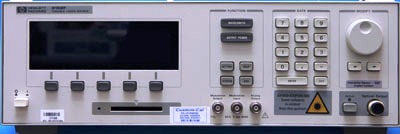
|
|
The HP 8168F tunable laser source is a basic tool for characterizing and testing optical amplifiers and components. The current values of wavelength and output power are indicated on a large and bright display. You can select both parameters independently within the specified range. If you change the output power, the wavelength remains stable, and if you change the wavelength, the output power remains stable. Just input a new wavelength and the instrument will set it immediately. With its coherence control mode made active, the HP 8168F will feature an effective linewidth of up to 500 MHz, thus drastically reducing the interference ripple. The internal modulation frequency is selectable between 250 Hz to 300 kHz for squarewave signals with 100% modulation depth (on/off). In the external modulation mode, the bandwidth is between 200 kHz and 20 MHz with a duty cycle depending on the input signal and a maximum modulation depth of ±15%. Specifications. Wavelength Range: 1450 nm to 1590 nm. Absolute Wavelength Accuracy: ± 0.1 nm. Relative Wavelength Accuracy: ± 0.050 nm (1450-1590 nm), typical ± 0.001 nm. Wavelength Resolution: 0.001 nm, 125 MHz at 1550 nm. Wavelength Stability (typical over 1 h at constant temp.): <± 100 MHz. Wavelength Repeatability: ± 0.050 nm, (1450-1590 nm), typical: ± 0.001 nm. Sidemode Suppression Ratio: 50 dB (1475 nm - 1575 nm at 1 dBm). Relative Intensity Noise RIN (typical): -145 dB/Hz. Linewidth (typical coherence control off): 100 kHz. Output Power: > +7 dBm (1520 nm -1570 nm), > -7 dBm (1450-1590 nm). Power Linearity: ± 0.1 dB/< ± 0.3 dB. Power Stability (over 1 h): < ± 0.03 dB (Typical 0.01 dB). Power Repeatability (typical): < ± 0.04 dB. Output Isolation (typical): 50 dB. Return Loss (typical): 60 dB. Modulating Frequency: 250 Hz - 300 kHz (squarewave). Built-in HPIB. Options. 003, Built-in Variable Attenuator. 007, Polarization Maintaining Fiber, Panda-type. 021, Straight Contact Connector. 022, Angled Contact Connector. 023, Angled Non-Contact Connector.
|